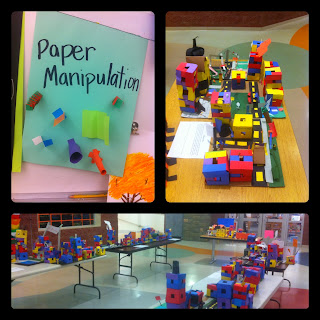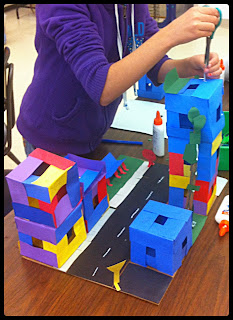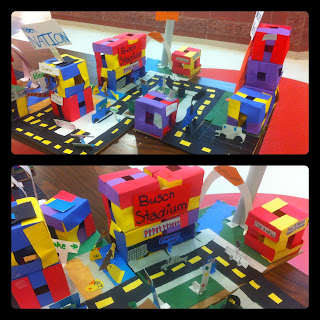I have spent the semester in a local elementary art classroom. These kids were great! and the teacher is so patient and willing and a wealth of art teacher knowledge. I get to student teach with her in the spring, Yay!!
Last blog I said I would offer the Cube project. Well, as I started in the art room, the cubes took a dramatic turn. (I love finding simple project ideas and developing them into elaborate art lessons- I'm a total Ed. geek like that :)
Here is the Cube:
and how to make it:
NOTE: the size of the strips of paper depends on how large you want the cubes. SIZES CAN VARY.
Here are the kids assembling their cubes
(this is a project for 4th grade and up)
This is where the "cubes" took a dramatic turn. We were discussing how we could use the cubes. Kids have the most amazing imaginations!
Cube Cities
(3D cityscapes)
Here is the constructivist lesson plan:
"Evaluate" is missing, but here is my basic rubric that I use with elementary students.
This one is for this specific project (concepts at the top would need to be changed per project).
After completing this lesson for the first time, there were SO many more components and concepts to be added. Mostly interdisciplinary ideas (ie: groups adding govt' buildings and such, since MO's 4th grade curriculum spirals with state govt' concepts- Maybe add some famous Missourian and architectural facts :).
So many great concepts could be incorporated!
Here are some more Project Progress Pics
The students had SO much fun working collaboratively on this project. And they were SO excited to show their parents at their 4th grade concert (during which, they exhibit their art work in the hallways).
Here are the completed city blocks placed into their cities. Each class came up with a name for their city.
 The students learned various paper manipulation (folding) techniques to build their cubes and to make attachments.
The students learned various paper manipulation (folding) techniques to build their cubes and to make attachments.
The pictures don't do the details justice.
Happy teaching and creating!!
-Jessie



























